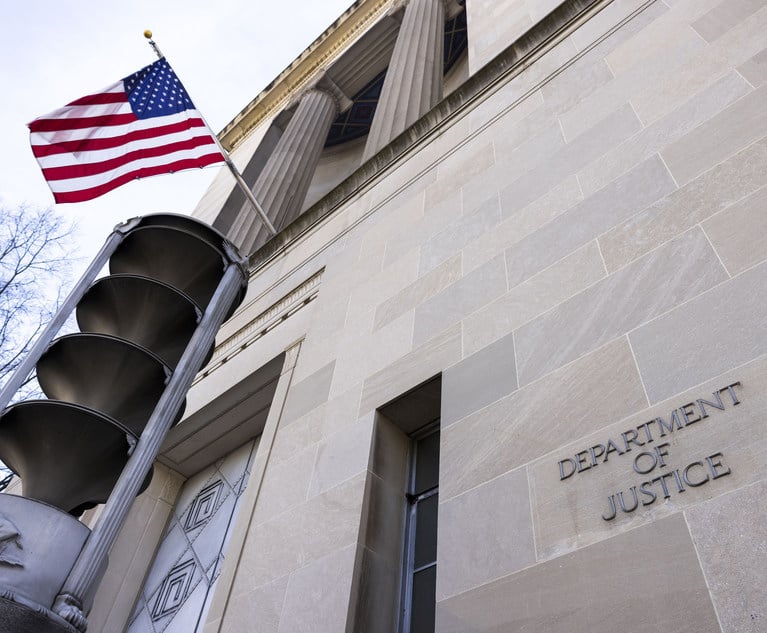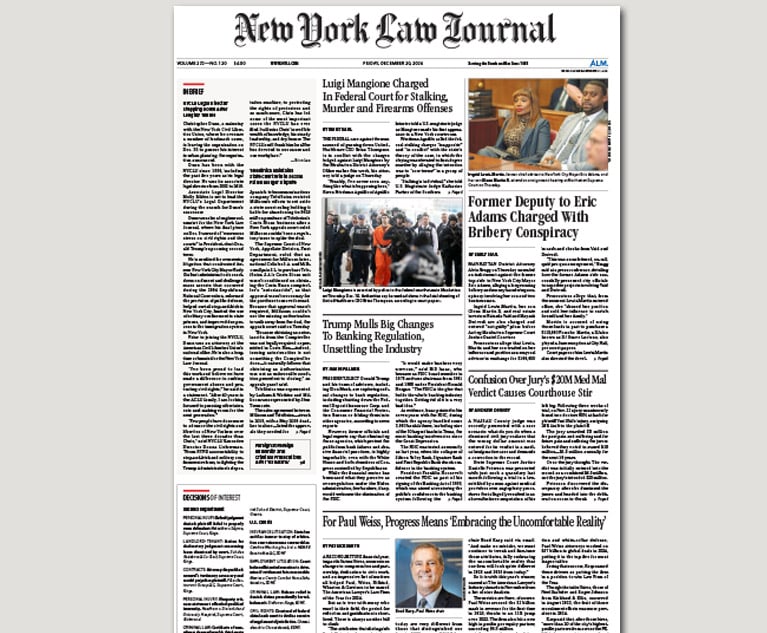 Justice Francois Rivera in his chambers at Brooklyn Supreme Court. Photo by David Handschuh/NYLJ
Justice Francois Rivera in his chambers at Brooklyn Supreme Court. Photo by David Handschuh/NYLJQ&A: A Brooklyn Judge Gives Student Interns Their Due
Justice Francois Rivera talks about his unique practice of educating student interns and giving them a hands-on role in the process of researching and writing opinions, often leading to a big impact in their careers.
October 02, 2019 at 06:23 PM
4 minute read
It's common knowledge that judges have help writing their decisions, but readers of Brooklyn Supreme Court Justice Francois Rivera's rulings might be surprised when they get to the end of his decisions and see the work of his student interns credited explicitly: "researched and drafted with the assistance of…"
In an interview with the New York Law Journal, Rivera talked about how it fits into his efforts to educate student interns and the impact it can have on their careers. This interview has been condensed and edited for style, grammar and clarity.
When and how did you end up crediting students for their work on decisions?
I've been doing it for a couple years now. Nobody told me to do it. I wasn't following anybody's lead. I did it on my own. I don't do it for clerks or court attorneys, just for a student, typically about to enter law school, or a rising 1L or rising 2L. For the last few years, I've been taking on students constantly. I sometimes take students who have limped through their first year of law school; they survived, but their grades aren't what they [expected].
I use the IRAC method—issue, rule, application, conclusion. I teach them how to read a statute. Look up everything; presume nothing. I go over appellate decisions with them. These students are used to reading the way you read college texts, which is a disaster in law school. It's a nightmare. You go through an entire semester with no quizzes, no tests, no nothing. And you're supposed to apply the law of every case you read on hypotheticals at the end. So when I take college kids and I give them decisions to read, I teach them to read deeply.
How does their work on one of your decisions fit into that process?
All these students are reading Appellate Division, Second Department decisions every week. They've got to read the top two or top three and discuss them with me and my court attorney. They start becoming comfortable with legal language.
I give students motion papers, make them read and discuss them, I give them the cases cited and the statutes, and we discuss what we think the outcome should be. College students actually reason through a decision through this method. I give them the decision template. And then they actually have to draft it using the template and using as a guide other decisions that I've written. They come up with a product that I'll edit. I make the drafting process one that's interactive, one where we reason through it together. And then they're saying, "I think that under this, this is what should happen." And I say, "why?"
One student published five opinions from me before law school. When he was interviewing, he was asked: "Do you know what a confession of judgment is?" "Oh, that's CPLR 3218." "How do you know about that?" "I've written in the area." "What do you mean?" "Just type my name in the Law Journal search box." He got the job on the spot.
Can you tell me about some of the highlights?
The fun is when they make the front page. Magdalena Oropeza's work on Ramos v. Uber and Rebecca Medina, with the "ferocious feline" case, both made the Law Journal. Steven Rivera, my son, wrote the "Lemon Juice" one that involved Internet anonymity. One of my students, Sabino Vargas, just got published in the Law Journal. He's thrilled about it.
So this is what I do. It's a joy. It's one of the fun things I do with students. I've never had anyone ask me about it. I did mention it to one or two of my colleagues, but it requires a commitment to work with students quite intensely.
This content has been archived. It is available through our partners, LexisNexis® and Bloomberg Law.
To view this content, please continue to their sites.
Not a Lexis Subscriber?
Subscribe Now
Not a Bloomberg Law Subscriber?
Subscribe Now
NOT FOR REPRINT
© 2024 ALM Global, LLC, All Rights Reserved. Request academic re-use from www.copyright.com. All other uses, submit a request to [email protected]. For more information visit Asset & Logo Licensing.
You Might Like
View All
'So Many Firms' Have Yet to Announce Associate Bonuses, Underlining Big Law's Uneven Approach
5 minute read
Government Attorneys Are Flooding the Job Market, But Is There Room in Big Law?
4 minute read
T14 Sees Black, Hispanic Law Student Representation Decline Following End of Affirmative Action
Trending Stories
Who Got The Work
Michael G. Bongiorno, Andrew Scott Dulberg and Elizabeth E. Driscoll from Wilmer Cutler Pickering Hale and Dorr have stepped in to represent Symbotic Inc., an A.I.-enabled technology platform that focuses on increasing supply chain efficiency, and other defendants in a pending shareholder derivative lawsuit. The case, filed Oct. 2 in Massachusetts District Court by the Brown Law Firm on behalf of Stephen Austen, accuses certain officers and directors of misleading investors in regard to Symbotic's potential for margin growth by failing to disclose that the company was not equipped to timely deploy its systems or manage expenses through project delays. The case, assigned to U.S. District Judge Nathaniel M. Gorton, is 1:24-cv-12522, Austen v. Cohen et al.
Who Got The Work
Edmund Polubinski and Marie Killmond of Davis Polk & Wardwell have entered appearances for data platform software development company MongoDB and other defendants in a pending shareholder derivative lawsuit. The action, filed Oct. 7 in New York Southern District Court by the Brown Law Firm, accuses the company's directors and/or officers of falsely expressing confidence in the company’s restructuring of its sales incentive plan and downplaying the severity of decreases in its upfront commitments. The case is 1:24-cv-07594, Roy v. Ittycheria et al.
Who Got The Work
Amy O. Bruchs and Kurt F. Ellison of Michael Best & Friedrich have entered appearances for Epic Systems Corp. in a pending employment discrimination lawsuit. The suit was filed Sept. 7 in Wisconsin Western District Court by Levine Eisberner LLC and Siri & Glimstad on behalf of a project manager who claims that he was wrongfully terminated after applying for a religious exemption to the defendant's COVID-19 vaccine mandate. The case, assigned to U.S. Magistrate Judge Anita Marie Boor, is 3:24-cv-00630, Secker, Nathan v. Epic Systems Corporation.
Who Got The Work
David X. Sullivan, Thomas J. Finn and Gregory A. Hall from McCarter & English have entered appearances for Sunrun Installation Services in a pending civil rights lawsuit. The complaint was filed Sept. 4 in Connecticut District Court by attorney Robert M. Berke on behalf of former employee George Edward Steins, who was arrested and charged with employing an unregistered home improvement salesperson. The complaint alleges that had Sunrun informed the Connecticut Department of Consumer Protection that the plaintiff's employment had ended in 2017 and that he no longer held Sunrun's home improvement contractor license, he would not have been hit with charges, which were dismissed in May 2024. The case, assigned to U.S. District Judge Jeffrey A. Meyer, is 3:24-cv-01423, Steins v. Sunrun, Inc. et al.
Who Got The Work
Greenberg Traurig shareholder Joshua L. Raskin has entered an appearance for boohoo.com UK Ltd. in a pending patent infringement lawsuit. The suit, filed Sept. 3 in Texas Eastern District Court by Rozier Hardt McDonough on behalf of Alto Dynamics, asserts five patents related to an online shopping platform. The case, assigned to U.S. District Judge Rodney Gilstrap, is 2:24-cv-00719, Alto Dynamics, LLC v. boohoo.com UK Limited.
Featured Firms
Law Offices of Gary Martin Hays & Associates, P.C.
(470) 294-1674
Law Offices of Mark E. Salomone
(857) 444-6468
Smith & Hassler
(713) 739-1250







